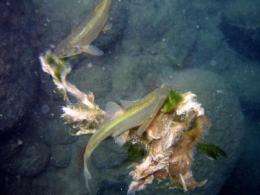Study of feeding behaviors points to challenges for native fish

(�鶹��ԺOrg.com) -- A study detailing the feeding behaviors of four species of fish found in the Colorado River and its tributaries uncovered a few surprises and opened new insights to the challenges faced by native fish species in the Southwest.
Some of the biggest challenges are relatively recent ones. In a diverse region known for its markers of geologic time, a combination of dam building and the introduction of nonnative species have dramatically reduced the survival chances of native fish, said Northern Arizona University researcher Alice Gibb.
A biology professor, Gibb is the corresponding author of a new paper, “Prey Capture Behavior of Native vs. Nonnative Fishes: A Case Study from the Colorado River Drainage Basin (USA),” that appears in the Journal of Experimental Zoology A.
That native fish in the Southwest are on the decline is not in dispute, but the research provides more evidence as to why.
“We altered the habitat native fish evolved for and put in fish that are better-adapted to the new conditions,” Gibb said, calling the changes a “one-two punch” for native fish.
For the study, Gibb and her colleagues compared the native roundtail chub with the nonnative smallmouth bass, and the native Sonora sucker with the nonnative common carp—species that occupy the same “ecological niche.”
While Gibb expected the nonnatives to consume everything offered to them, the study found that it was the native fish that had a broad diet in the lab. The nonnatives were choosier.
“I would interpret the native feeding as opportunistic behavior,” Gibb said. But it’s a behavior that evolved in the constantly changing habitat of the Southwest in warm, turbid water. The nonnatives, Gibb said, are from more stable and clear conditions—just like those created by the introduction of dams.
Gibb also noted that the nonnatives have bigger mouths. “That’s going to provide an advantage, especially when it comes to eating other fish,” she said. Smallmouth bass, for example, can eat chub—but not the other way around—and they have a better chance of doing so in clear water.
“The research results suggest that it’s the conditions that favor the nonnatives,” Gibb said.
Considering that those conditions are human caused, the findings have implications for wildlife management.
“You can try to extirpate the nonnatives,” Gibb said, noting an environmental restoration of Fossil Creek that has created a reservoir habitat for native fish. “But people want their sport fish, which are good predators in clear conditions.”
Such dynamics are not the case only in the Southwest. Gibb said there is growing worldwide interest in a field known as “invasion ecology.”
“It’s an area that’s recently been recognized as a tool to understand why some species go extinct and others take over.”
Provided by Northern Arizona University




















